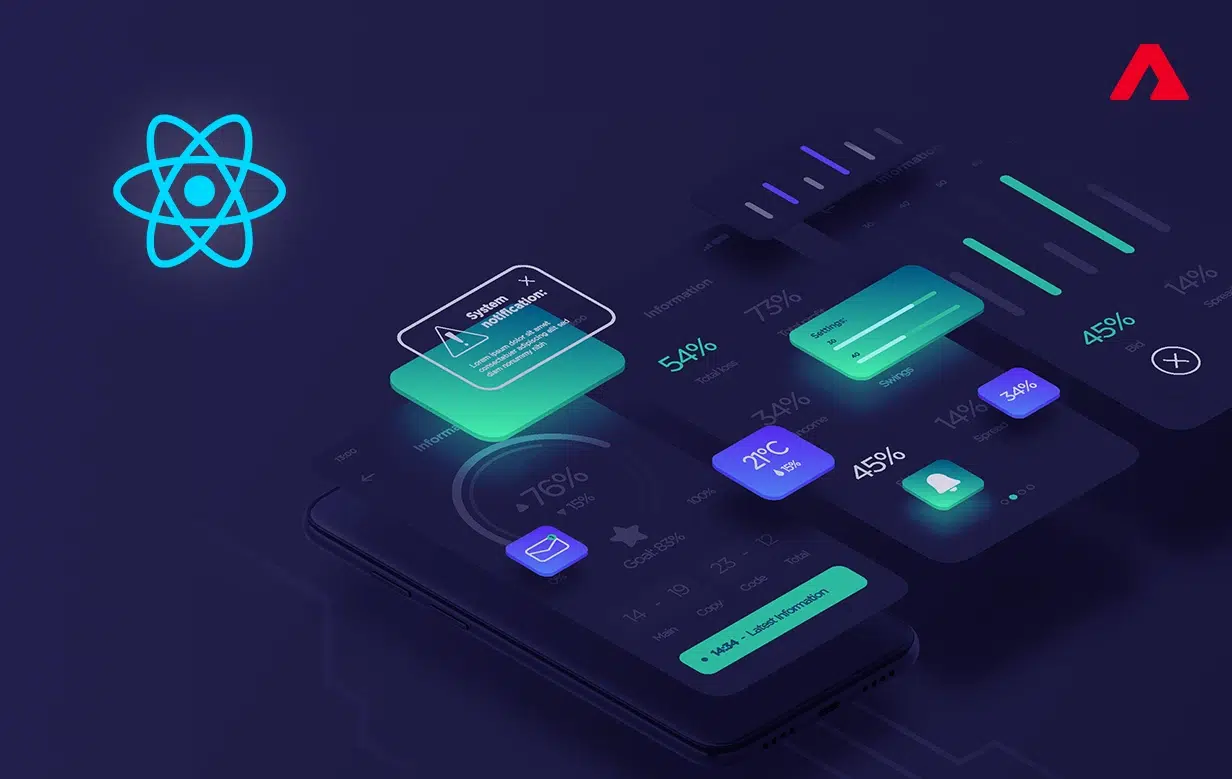React Native has become one of the most popular frameworks for building cross-platform mobile apps. It allows developers to write once in JavaScript and run their code on both iOS and Android. Technically this process is helpful in saving significant time compared to native development. Additionally what makes an app stand out in today’s crowded app stores is the way it delivers UX effortlessly.
Animations are absolutely essential for applications in order to remain competitive. These animations guide user attention, provide feedback, and make interactions feel natural. When you swipe down on a feed and the list bounces back, it’s not because the app needed to, it’s because that bounce gives you a sense of completion. Subtle animations like this can determine whether users find your app polished.
React Native, while powerful, does not include advanced animation capabilities out of the box. This has led to the creation of a rich ecosystem of third-party libraries and UI components that focus on smooth motion, performance, and ready-made design patterns. Over the years, some libraries have become staples for developers, while others are newer but bring fresh ideas to the table.
Let’s take a closer look at some of the most trusted animation libraries and UI components in the React Native ecosystem, and why developers keep reaching for them when building modern apps.
Most Popular React Native Animation Libraries
Reanimated
It is the backbone of complex animations and if you’ve spent any time exploring animation in React Native, you’ve likely come across React Native Reanimated. This library has become the backbone for developers who need high-performance animations without pushing the JavaScript thread to its limit.
Unlike the default Animated API, which sometimes struggles with frame drops, Reanimated works at the native level. This means transitions and gestures run smoothly even on lower-end devices. Developers appreciate that they can express animations in JavaScript but have them executed natively, avoiding the dreaded lag that turns users away.
However, version 2 of Reanimated introduced a more declarative API and “worklets,” making it easier to write complex gesture-based animations that respond in real time. For apps that rely on fluid swipes, draggable elements, or custom transitions, Reanimated is usually the first choice. It requires a learning curve, but once developers get used to its mental model, it unlocks possibilities that are hard to achieve with other solutions.
React Native Gesture Handler
Animations and gestures go hand in hand. A swipe without feedback feels broken, and a tap without response feels unacknowledged. This is where React Native Gesture Handler comes into play.
While React Native does support touch gestures out of the box, the native handler often feels limited for complex interactions. Gesture Handler extends those capabilities by providing more control over how gestures are recognized and combined. Developers often pair it with Reanimated to build advanced gesture-driven animations, such as card swipes, bottom sheets, or nested scrollable views.
What makes Gesture Handler stand out is its ability to manage competing gestures gracefully. For example, if you have a horizontal carousel inside a vertical scroll view, the library decides intelligently which gesture to prioritize, creating a seamless user experience. Without it, developers usually run into “gesture conflicts” that break the smoothness of navigation.
Lottie
Sometimes, you don’t want to reinvent the wheel by coding every animation from scratch. Designers often create rich animations in Adobe After Effects, and exporting them for mobile used to be a nightmare. Fortunately that has changed to an extent when Airbnb introduced Lottie.
It allows developers to play After Effects animations inside React Native apps using JSON files. Instead of coding a loading spinner, you can use a beautifully designed animation provided by your design team. Instead of static illustrations, you can add delightful micro-interactions without bloating the app with heavy video files.
One of Lottie’s biggest strengths is its performance. The animations are vector-based, so they scale perfectly across different screen sizes without losing quality. And because they’re lightweight, they don’t inflate the app size like GIFs or videos would.
Many popular apps use Lottie for splash screens, onboarding flows, and button animations. It has become a bridge between designers and developers, letting creative teams bring their ideas into production apps with minimal friction.
Moti
Moti is known for its simplified animation with a Developer-Friendly API. It has emerged as a friendlier alternative for developers who find Reanimated powerful but intimidating. Built on top of Reanimated 2, Moti abstracts away much of the boilerplate, giving developers a simpler API for common animation patterns.
With Moti, animating a component is as straightforward as adding a few props. You can animate opacity, translate elements, or create staggered lists with minimal code. Behind the scenes, it still leverages Reanimated’s high-performance engine, so developers don’t sacrifice smoothness for convenience.
This library has become especially popular for developers who need to prototype quickly or who don’t want to dive deep into the complexities of Reanimated. In many cases, Moti can handle 80% of the animation needs in an app, leaving Reanimated for the more advanced edge cases.
React-Native-Animatable
Before Reanimated became dominant, React Native Animatable was the go-to solution for quick animations. While it may not have the cutting-edge performance of newer libraries, it remains useful for straightforward tasks like fade-ins, bounces, or slide transitions.
Animatable is all about speed of implementation. Developers can assign animations through simple props without writing complex code. For example, animating a button on press or making a card shake on error requires just a line or two.
It might not be the best choice for gesture-driven interfaces or large-scale performance-critical apps, but for smaller projects or quick prototypes, Animatable still gets the job done with elegance.
UI Component Libraries with Built-in Animations
Beyond dedicated animation libraries, many React Native UI kits come with polished, animated components out of the box. These save developers time and ensure a consistent design language throughout the app.
Libraries like React Native Paper, NativeBase, and UI Kitten provide ready-to-use components such as modals, bottom sheets, snackbars, and navigation bars, many of which include smooth transitions and feedback animations. While they aren’t animation libraries in the strictest sense, they cover a lot of everyday needs without forcing developers to reinvent patterns.
For teams working on tight deadlines, these component libraries are invaluable. They handle both design consistency and user interaction, allowing developers to focus on business logic instead of fine-tuning animations for every button and card.
Pro tip for Choosing the Right Library for Your App
As React Native continues to evolve, animation libraries are also becoming more sophisticated. The focus has shifted from simple transitions to truly fluid, gesture-driven experiences that feel indistinguishable from native apps.
The abundance of choices raises an important question that which library should you actually use? The answer depends heavily on the type of app you’re building and the experience you want to deliver.
In fact, many production apps use a combination of these libraries because there’s no single “best” tool. Instead, successful teams pick the right one for the job at hand, balancing performance, complexity, and development speed.
The community around Reanimated and Gesture Handler is particularly active, constantly refining APIs and improving performance. Libraries like Moti are lowering the barrier to entry, allowing junior developers to deliver smooth animations without weeks of study. Meanwhile, Lottie continues to bridge the gap between designers and developers, making collaboration more seamless.
Certainly, user expectations for mobile experiences are not going down. As hardware gets faster and apps compete for attention, smooth animations will remain a vital part of mobile design. Developers who invest time in mastering these libraries position themselves to deliver apps that not only work but delight.
Conclusion
React Native may have started as a framework focused on cross-platform functionality, but in today’s competitive app landscape, user experience is just as important as code efficiency. Animation libraries and UI kits provide the polish that transforms an app from usable to enjoyable.
Whether it’s the raw power of Reanimated, the designer-friendly workflow of Lottie, or the simplicity of Moti, these tools give developers the flexibility to create apps that feel modern, fluid, and engaging. Choosing the right combination isn’t about following trends, it’s about understanding your users and delivering an experience that feels natural in their hands.
If you’re building your next mobile app with React Native and want to leverage these libraries effectively, consider working with our experienced React Native Development Company. At Atharva System, we’ve helped startups and enterprises craft mobile experiences that stand out. From prototyping to production, we make sure every animation feels right and every component serves the bigger vision.
Let’s build mobile experiences that move as smoothly as your ideas.
Contact us at contact@atharvasystem.com
Visit us at https://www.atharvasystem.com to learn more.
FAQs
1. Do I need to use an animation library in every React Native project?
Not always. For small projects, the built-in Animated API might be enough. But if performance and smooth gestures are important, third-party libraries are usually worth it.
2. Which library is best for beginners in React Native animations?
Moti and React Native Animatable are great starting points because of their simple APIs. Developers can get results quickly without diving into complex concepts.
3. Is Lottie suitable for production apps?
Yes. Lottie is widely used in production by companies like Duolingo and Uber. It’s lightweight and scalable, making it perfect for polished animations.
4. Can I combine multiple libraries in the same app?
Absolutely. Many apps use Reanimated for gestures, Lottie for branded animations, and UI kits for everyday transitions. The key is to balance complexity with performance.
5. Do animation libraries slow down the app?
When used correctly, they don’t. Libraries like Reanimated run animations on the native thread, which keeps performance smooth even on budget devices.
6. How do UI component libraries help with animations?
UI kits such as React Native Paper or NativeBase provide pre-animated components, saving developers time and ensuring design consistency across the app.
7. Why work with an expert team for animations?
Animations can make or break the user experience. An expert team ensures the right libraries are chosen, integrated correctly, and optimized for real-world devices.




 Insurance
Insurance

























